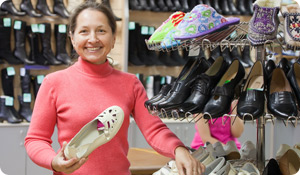
Falling and hurting yourself becomes a real danger as you get older, especially if you don't get enough exercise, have vision problems, take sedating medications, suffer from osteoporosis or other bone-weakening conditions, or there are environmental hazards in your home, such as loose rugs, poor lighting, or unstable furniture or fixtures. While there are specific steps you can (and should) take in each of these situations to reduce your risk of getting hurt, wearing appropriate, well-fitted shoes can help keep you grounded and prevent falls that might result in serious injury.
The shoes that are most appropriate for you are the shoes that keep you stable and help you function normally, even if you have problems with your feet, toes, or ankles. For some people, that simply means a comfortable, properly sized, well-made walking or running shoe that can be found in any good shoe store. For others, it can mean therapeutic or orthopedic shoes or shoe inserts (orthotics) that are specially designed to fit individual feet and are available by prescription from a podiatrist.
Just as your shoe size changes, so does the shape of your foot. If you have bunions, heel spurs, hammertoes, plantar fasciitis, or other foot problems common with aging, you may need both a larger and wider shoe than you have worn in the past. Even if you don't have any of these problems, the front of your foot may have widened somewhat with age.
Finding a comfortable shoe can be as simple as knowing what size you wear. Your shoe size changes as you get older, so it is important to have your feet measured from time to time. You may have worn a size 7 most of your adult life, but now you find that you need a size 7 1/2 or 8, or even larger. This is normal.
These tips can help you stay on your feet for years to come:
- Choose supportive shoe styles with low heels and nonskid or rubber soles. If you're not sure what type of shoes are best for you, speak with your primary care physician or a podiatrist.
- Buy shoes by their fit, not by their size. Shoe sizes vary among brands. A size 8 in one type of shoe may not be the same as a size 8 in another.
- Wear shoes indoors and out. According to researchers at Harvard Medical School, people who wear shoes in the house, rather than slippers or socks, are less likely to suffer serious injuries from falls.
Sources:
Colorado State University Extension: Preventing Falls in the Elderly Web 27 Dec 2011http://www.ext.colostate.edu/pubs/consumer/10242.html
Harvard Medical School: Feet and Falling Web 27 Dec 2011http://www.health.harvard.edu/newsletters/Harvard_Health_Letter/2011/November/feet-and-falling





